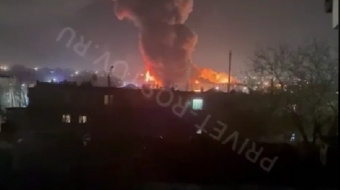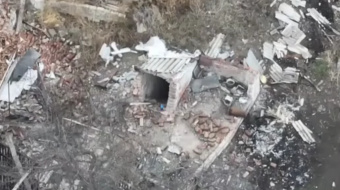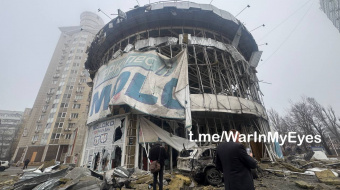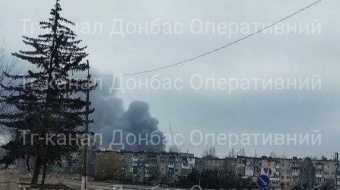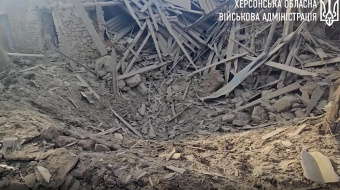Town on the front line. Volnovakha everyday life
Town on the front line. Volnovakha everyday life
“Kyiv-Mariupol” train. Volnovakha taxi drivers fuss around people who have just arrived. “Were are you going, girl?” “Let’s go to the checkpoint”, “Get into my car”. The locals say that taxi drivers have already shared train carriages and divided the territory. They can take you to the first Ukrainian checkpoint in Novotroitske for 200-300 hryvnyas. Local taxi drivers and those who own cars earn quite a lot of money taking people who arrive in Volnovakha to checkpoints. They earn at least 800-1500 hryvnyas a day. It used to take 45 minutes to get to Donetsk which is 60 kilometres away, not it will take from 5 to 15 hours.
There are a lot of buses leaving from Volnovakha bus station. They go all around Ukraine and they also go to ... Russia. Before the war there did not use to be even a bus to Rostov-on-Don which is nearby, but now you can go to Krasnodar, Moscow, Voronezh.
All the destinations are in high demand and the bus station itself has changed, it has become more comfortable and spacious and there is an indoor toilet instead of an outdoor privy.
Volnovakha has turned into a transit point where residents of occupied territories arrive before going to other localities. It is also full of so-called “tourist IDPs”, these are people who come from Donetsk to get an IDP certificate, pensions or welfare allowances. They can be easily recognized as they usually queue to ATMs or social services.
“We got up at 4 a.m. to leave Donetsk and we arrived here at 10 a.m. Now we are queuing to take out money, then we’ll buy some things we need and go home”, says an elderly woman. We asked why they do continue living on occupied territory, she answers: “At least we have home there and where will we live here? Who needs us?”
Has the war influenced Volnovakha? Of course but not radically. Ordinary people have got used to militaries in the town and salvos far away.
Officially, there is no curfew in the town but the centre which used to be full of young people in the evenings is now practically empty after 7 p.m. You can only see militaries or the police. A lot of people feel discomfort due to this atmosphere.
Internally displaced persons started coming here two years ago and they still arrive. It is problematic to rent some accommodation in Volnovakha. The price is from 500 hryvnyas if you are lucky to 2000 hryvnyas. This is why a lot of people are looking for a flat to share with someone. Volnovakha mostly consists of little detached houses and not all city residents can adapt to its empty streets and morning “Cock-a-doodle-do”.
The locals are quite sympathetic with IDPs. They do not hate and even understand them. Some IDPs who now live here have, in fact, returned home as they used to work in Donetsk and come here for the weekend. These are young people mostly. A lot of them had to start from scratch when they returned. Some of them went back to Donetsk or to another city later.
There are a lot of entrepreneurs in the town now especially among those who render different services, transportation or help with getting permits or certificats. There are new shops and kiosks. A lot of people prefer markets, though, as they are cheaper and offer a wide selection of food. Market is the favourite place of IDP tourists. It is important not to confuse hryvnyas and rubles when you pay. “I saw a woman who was paying for some goods and accidentally took out a Russian note. The seller refused to accept it”, says Maxim, a local. He says that Donetsk residents are trying to buy as many things as they can.
People learn the news on the Internet, mostly. They actively discuss events in the town and skirmishes nearby. The locals read and watch Ukrainian news as well but not all of them can do this. Seniors, for example, cannot fix antennae themselves so they have to watch Russian propaganda or read the only newspaper in the district “The Nashe Slovo”. The information it provides is quite balanced, it tells about local everyday life and events on the front line with patriotism but without too much pathos.
By the way, patriotic views are quite moderate in the town. “People do not want “DPR”, they want to live in Ukraine, but they are not happy with Ukrainian authorities”, says one of activists. There are a lot of national symbols everywhere, from primary schools to fences. There is also the Coat of Arms of Ukraine on the facade of one of blocks of flats.
However, national identity of the town residents themselves is more important. More people come to festivals and commemoration ceremonies wearing vyshyvankas which used to be a rare case here before the war.
As for decommunization, 38 streets of the town have been renamed according to the law.
By the way, Volnovakha was the first town which named a street after late Ukrainian singer Kuzma. The main communist symbol, Lenin monument, was first patriotically “dressed” (in sharovary and vyshyvanka, traditional Ukrainian trousers and a shirt), but that did not help it. Later it was dismantled.
Olha Astakhova for “OstroV”
New service "Explain Ukraine". This is a daily mailout of three articles which were written about the situation in the Donbas by Donbas journalists and translated into English. Honest vision of people who work in the field is unbiased and fresh which is crucial in the world which is full of desinformation and propaganda. We try to share this vision in out daily mailout. You can subscribe here.











